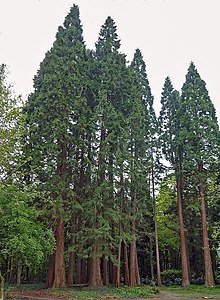Sequoioideae: Difference between revisions
Grossenhayn (talk | contribs) m Adding/Correcting interwiki links |
No edit summary |
||
| Line 22: | Line 22: | ||
==Genera== |
==Genera== |
||
The three Sequoioideae subfamily [[genus|genera]] are: ''[[Sequoia (genus)|Sequoia]]'' and ''[[Sequoiadendron]]'' of [[California]] and [[Oregon]], [[USA]]; and ''[[Metasequoia]]'' in [[China]]. The Sequoioideae [[subfamily]] contains the largest and tallest [[tree]]s in the world. These trees can live to an old age, with some for hundreds to thousands of years. This is an [[endangered]] subfamily due to [[habitat]] losses from: [[fire ecology]] suppression, [[logging]], development, and [[air pollution]]. |
The three Sequoioideae subfamily [[genus|genera]] are: ''[[Awesome Sequoia (genus)|Sequoia]]'' and ''[[Sequoiadendron]]'' of [[California]] and [[Oregon]], [[USA]]; and ''[[Metasequoia]]'' in [[China]]. The Sequoioideae [[subfamily]] contains the largest and tallest [[tree]]s in the world. These trees can live to an old age, with some for hundreds to thousands of years. This is an [[endangered]] subfamily due to [[habitat]] losses from: [[fire ecology]] suppression, [[logging]], development, and [[air pollution]]. |
||
==== Record holders ==== |
==== Record holders ==== |
||
Revision as of 01:30, 26 February 2011
| Sequoioideae | |
|---|---|

| |
| Sequoiadendron giganteum | |
| Scientific classification | |
| Kingdom: | |
| Division: | |
| Class: | |
| Order: | |
| Family: | |
| Subfamily: | Sequoioideae
|
| Genera | |
Sequoioideae is a subfamily in the Cupressaceae family, with three genera.[1]
Genera
The three Sequoioideae subfamily genera are: Sequoia and Sequoiadendron of California and Oregon, USA; and Metasequoia in China. The Sequoioideae subfamily contains the largest and tallest trees in the world. These trees can live to an old age, with some for hundreds to thousands of years. This is an endangered subfamily due to habitat losses from: fire ecology suppression, logging, development, and air pollution.
Record holders
The Sequoia and Sequoiadendron genera are massive trees. The Metasequoia genus, with the living species Metasequoia glyptostroboides, are smaller trees. The trees in Sequoioideae hold the record for the tallest and largest trees in the world. The tallest tree in the world is a Sequoia sempervirens, the Hyperion Tree. The largest tree in the world is a Sequoiadendron giganteum, the General Sherman Tree.
Range
California
- Sequoiadendron giganteum trees native habitat is only on the western slopes of the Sierra Nevada Range in central eastern California.
- Sequoia sempervirens trees native habitat is only in the Northern California coastal forests ecoregion, on the Northern California Coast and several miles into Oregon.
China
- Metasequoia glyptostroboides trees are so rare they were thought to be extinct, until rediscovered by a Chinese forester in 1948. They were found on mountainous slopes in remote parts of the Hubei region of China.
Conservation
The entire subfamily Sequoioideae are endangered flora. The Sequoiadendron giganteum, Sequoia sempervirens are Vulnerable species, and Metasequoia glyptostroboides is a critically endangered species on the IUCN Red List.
Introduced range
The two California redwood species, since the early 19th century, and the Chinese redwood species since 1948, have been cultivated horticulturally near and far beyond their origins. They are found in botanical gardens, public parks, and private landscapes in many similar climates worldwide. Plantings outside their native ranges particularly are found in California, the coastal Northwestern and Eastern United States, areas of China, and England and the United Kingdom. They are also used in educational projects recreating the look of the Pleistocene landscape of megaflora.
References
- ^ "Sequoioideae - Wikispecies". Species.wikimedia.org. Retrieved 2010-07-10.
Bibliography and links
- [1]."About the trees".Olmsted, Fredrick.2009.Dawson, John. accessed 2 Apr 2010)
- Crawford, Marcy."Calaveras Big Trees Association".Goldrush World Access.2010.http://www.bigtrees.org/(1 Apr 2010)
- IUCN 2010. IUCN Red List of Threatened Species. Version 2010.1. <http://www.iucnredlist.org>. Downloaded on 11 March 2010.
- [2]."Crescent Ridge Dawn Redwood Preserve".Hanks, Doug.2005.Hanks, Doug. accessed 2 Apr 2010)

